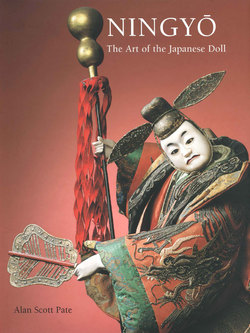Ningyo

Реклама. ООО «ЛитРес», ИНН: 7719571260.
Оглавление
Alan Scott Pate. Ningyo
Отрывок из книги
Osome Meiji period, late 19th century
Height 36 1/2 inches
.....
In the late eighteenth century, mitate gosho-ningyō based directly on Noh themes and plays became popular. Known simply as noningyō (Noh dolls), these figures displayed a particularly high level of artistry and sensitivity. Figures nearly as tall as a small child, two feet in height and larger, were created, elaborately costumed in textiles closely approximating those worn on the Noh stage. Noningyō, however, were rarely, if ever, created with masks, a signature element of the Noh drama itself. Karakuri (mechanical) gosho frequently have masks attached depicting the faces of Okina or some other highly recognizable figure, but nō-ningyō relied on the intimate knowledge of the viewer to reveal their identities: tableau images re-enacting scenes from famous plays were created, figures grouped in telling ways, with their accessories and textiles giving a name to the unspoken drama presented.
As a dramatic form, Noh had its origins early in Japanese history, in ritual dances held at Shintō shrines designed to entertain the gods and to invite blessings. Buddhist priests from certain esoteric sects also used performance to educate and convey their religious ideals to the public. Lay itinerant performers traveled the countryside as well, using shrine and temple precincts in which to showcase their talents that included brief skits, dance, and acrobatics. Called sarugaku (monkey music), these performances gradually became more sophisticated, frequently taking on some of the more sacred elements of their religious counterparts. The chronology of this early development is unclear, but by the end of the Heian period, certain Noh dances that we recognize today, such as Okina, were already established pieces with a highly cultured patronage and a rapidly developing material culture.
.....